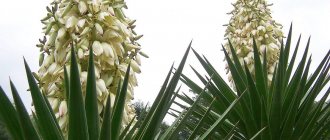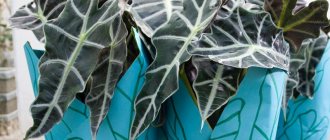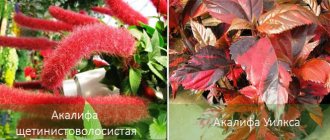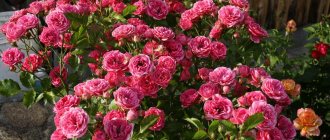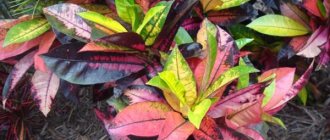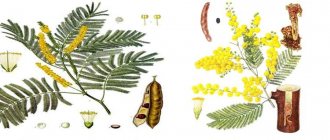Origin and appearance of cornflowers
Simple and beautiful flower
You can find it in almost all European countries. Most often where they are actively engaged in farming. Cornflower, a wildflower, has become a real disaster for rye crops, actively growing among the cereals and causing considerable harm to the crops.
In general, every person who at least sometimes gets out of the city knows what a cornflower looks like. But it won’t hurt to tell you briefly.
Cornflowers of the Aster family, or Asteraceae, can be either annual, biennial or even perennial plants. The stems are straight and quite tall - from 50 to 80 cm.
Flowers form an exquisite basket. Moreover, the color scheme can be very different. There are white, yellow, blue, purple, red, yellow, lilac, burgundy and others. Of course, thanks to this, cornflower is a plant of considerable interest to many breeders.
The leaves are very narrow, weakly defined and often adjacent to the stem, which may make it seem as if they are not there at all.
An additional advantage is that it blooms for a very long time - it starts in mid-June and ends in early-mid October, when the first night frosts hit.
For reference! According to legend, there lived a guy named Vasily and a mermaid fell in love with him. When he rejected her offer to live under water, she was offended and said: “You will always live on the field!” and turned the unfortunate man into a beautiful flower.
Cornflower blue shoes
Cornflower blue sandals are an interesting and stylish accent to your look. They attract admiring glances and admiration. Cornflower blue pumps with cropped, rolled-up skinny jeans are an incredibly simple but trendy combination. Depending on the type of shoe, adjustments are made to the purpose of the bow:
- Boats
. The most comfortable, stylish and classic type of shoe. It can be used in any occasion: for the office, a date, business negotiations, a party and an informal meeting in a cafe with friends, it all depends on the clothes with which these shoes are complemented. - Loafers. Practical and comfortable shoes for everyday wear. They are convenient for long walks and shopping. Interesting with jeans, floor-length dresses and rompers.
- Mules
. A new trend in the world of fashionable shoes. They represent sandals with an open heel and a closed toe, with heels or flat soles. Due to their shape, they are very convenient to use.

Types and varieties of cornflower
Cornflower flower
Of course, before you plant a cornflower flower in your garden, you need to find out the description of the different varieties. Still, there are quite a lot of wild varieties, between which there is almost no difference in care, but in appearance they are very different from each other. This means there is a great opportunity to decide which one is best suited for the flowerbed.
Cornflower

This is not a flower, but a whole inflorescence
Perhaps one of the most common members of the family. On the one hand, it is quite beautiful, has large flowers of a rich blue color - similar to flax. It grows quite large - some stems reach 120 cm in height!
However, the plant is considered a weed, so it is actively combated. In addition, it poses a considerable danger to some animals. Due to the fact that the stems contain phenol derivatives, horses that eat a large amount of cornflower may well become seriously poisoned.
Cornflower yellow
The real name of this ornamental plant is Grossheimia macrocapitatum. It is a perennial plant.
- The stems are quite tall - they can reach a meter in height.
- The inflorescences are very large - in some plants the diameter reaches 5 cm.
- The shape is quite unusual, as is the color - a yellow ball.
The bright yellow heads cause them to resemble thistles rather than their close relative, cornflower. The bottom of the bud is covered with paper-like scales, and the leaves are rough to the touch, rather rough. Unfortunately, it blooms quite a bit - no more than two months, usually from the beginning of July to the end of August.
Attention! Cornflower has medicinal properties - it can be used as a diuretic, which helps with swelling and kidney disease.
White cornflower
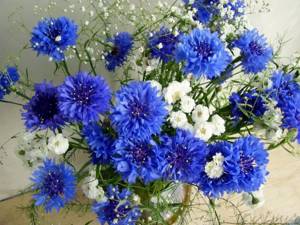
Luxurious bouquet of cornflowers
Quite an unusual variety, more like a chamomile.
The flower, as the name suggests, has white petals. It is found most often in the Caucasus and sometimes in northern Iran. When grown, it forms a rather dense but low bush - no more than 55 cm. The lower leaves are dissected, the upper ones are more even. The diameter of the inflorescences can easily reach 4 cm.
In general, this meadow flower is of considerable interest to breeders. On its basis, unusual varieties were bred, including John Coutts, distinguished by its soft pink color. It begins to bloom at the end of July and blooms until the end of September.
Pink cornflower
As the name suggests, the color of cornflower is pink. But this is not the only interesting feature. This plant also boasts the largest flower in the family - up to 8 cm in diameter. And it smells great too. It is not surprising that many gardeners prefer to use this particular perennial for growing.
It is very beautiful when flowering, but faded flowers spoil the appearance, so it is advisable to remove them regularly.
For reference! The ancient Greek name for the flower is Centaurea, meaning centaur (or centaur). According to legend, the centaur Chiron managed to recover from the poison of the Lernaean Hydra by using cornflower juice.
Eastern cornflower
Another perennial plant. The flowers are vaguely similar to dandelion - yellow, consisting of many tiny petals. It is distinguished by its unpretentiousness - it overwinters easily, grows on almost any type of soil and can easily tolerate even prolonged drought without harm to itself.
It grows in length up to 80-120 cm - it all depends on whether it gets enough sunlight.
True, it does not bloom for long - most often only a month in mid-summer. And the flowers are not too large - rarely more than 3 cm. Therefore, the species is not included in the list of the most popular cornflowers.
Cornflower purple
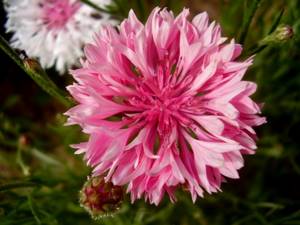
Unusual color
A real gift for gardeners who love cornflowers - the flowers of this variety are truly deep purple. The magnificent aroma will be a pleasant addition to the beautiful flowers, the size of which, by the way, reaches 5 cm, so they cannot be called small.
An annual plant reaching a height of 70 cm. The stem is covered with bright green leaves with jagged, jagged edges. If the weather is good, it can bloom for a very long time - from early summer to mid-autumn. At the same time, purple cornflower, like all its relatives, easily tolerates drought.
What field cornflowers look like, description
The stem is rough and ribbed, depending on the growing area from 15 to a meter in height. The leaves are lanceolate, pubescent, sessile. The flowers have different shades: from white to blue and purple-lilac. Blooms all summer, from June to October.
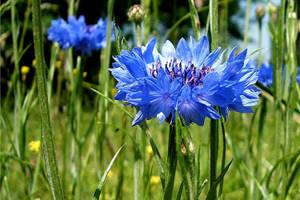
Cornflower
The large flower of blue cornflower, the most famous of the genus Cornflowers, is a basket with flowers of two types:
- the extreme ones are blue, funnel-shaped, asexual;
- the middle ones are dark blue with a violet tint, bisexual, fertile, tube-shaped.
The fruit is a reddish-colored achene; if you look at it from above, the tuft is clearly visible.
What you need to know to plant cornflowers
Of course, to create a chic garden, you need not only to know how to spell cornflowers or cornflowers, but also to learn certain planting rules. Fortunately, they are light enough that even a child can handle them, not to mention a more or less experienced gardener.
How to choose the optimal location
Jasmine - a flower for the garden, planting and caring for shrubs
It all starts with choosing a suitable location. If you don’t make mistakes here, the flowers will grow without causing unnecessary problems. Conversely, if you plant in an area with unsuitable conditions, you can spend a lot of time and effort, but not achieve the desired result.
The best place would be a flat area that is illuminated from morning to evening - the plant is not afraid of excessive heat with sufficient moisture. To increase their decorative value, it is advisable to plant cornflowers next to low-growing flowers or shrubs - they will look simply excellent.
Interesting ! The flower received recognition not only from flower growers, but also from artists - the desire to paint it was expressed by Bilibin, Levitan, Gribar and many other famous artists.
Step by step planting process
The easiest way to get beautiful flowers in your garden is to use seeds. The planting process is best carried out in late September or early August.
The planting scheme depends on whether the gardener uses large or small varieties. It can vary from 10x10 to 20x20 cm. So, it will be useful to know in advance how compact the plant is planted - this will avoid serious problems in the future.
- The earth is loosened in advance, at the same time making shallow holes - about 1.5 cm.
- The seeds are simply laid out in the prepared holes.
- Then they cover themselves with earth.
- Water abundantly - of course, only if there was not heavy rain shortly before, which well moistened the soil.
There is also an alternative method of planting - cuttings and roots. But it is used only when working with perennial species and is completely unsuitable for annual species. A serious advantage of this solution is the fact that the transplanted plant exactly retains all the features inherent in the mother plant.
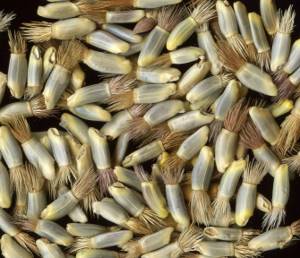
Cornflower seeds
Types and varieties
Physostegia flower - outdoor care
Currently, there are about 500 varieties of this ornamental plant in the world, both annual and perennial. The following are considered the most common.
Cornflower
This variety is widely used in scientific and traditional medicine. Cornflower, due to the fact that it is rich in substances that enhance urine flow and sweating, is used as a diaphoretic and diuretic.
It will not be difficult to prepare raw materials for the plant, since this species grows in meadows and fields among crops.

Cornflower
Note! Field cornflower is also called blue. This perennial plant is unpretentious, tolerates frost and drought well, and grows very quickly. The flower is little susceptible to pests and diseases; it blooms for a long time from early June to late autumn. It is thanks to these characteristics that he has earned the love of flower growers.
Its stem is thin, erect and prone to lodging. Cornflowers as wildflowers come in a blue hue that can range from dark blue to purple. The leaves are grey-green. Inflorescences are collected in single baskets.
Yellow
A perennial plant that grows up to 100 cm in height. The flowers of cornflower are yellow, up to 5 cm in diameter, and bright in color. The leaves are formed on straight and thick stems of an oblong-lanceolate shape.
White
The flower reaches a height of 30 cm. This variety is listed in the Red Book due to its uniqueness. White cornflowers are almost impossible to find on the street. They are mainly planted in scientific botanical institutes or botanical gardens. The flower is distinguished by small baskets and a white tint of flowers.

White cornflower is a rare species that is listed in the Red Book
Pink
Almost every gardener can find pink cornflowers in his garden or on his personal plot. The plant is distinguished by small single inflorescences and grows up to 1 m in height. The flower has a pink tint. The variety blooms from mid-summer to late autumn. The stems of the plant are erect, the leaves are light green.
Oriental
A perennial plant with a height of 80 to 130 cm. The leaves are formed on long petioles. Yellow flowers are collected in an inflorescence basket. Oriental cornflowers are wild flowers. The leaves of the plant are pinnately dissected, and the flowers are predominantly bright yellow.
Violet
The flower is distinguished by a thin and rod-shaped stem. Purple cornflowers reach a height of 80 cm. The leaves are obovate-lanceolate. The flowers are from lilac to lilac-purple. The perennial blooms from early summer until September. After flowering, fruits form on the stem. The plant reproduces by seeds.
In addition to the varieties listed above, there are many more varieties that amaze with their appearance. For example, such as Red ball, mountain, whitened, musky, etc. Which one to grow in your garden, each gardener decides independently.
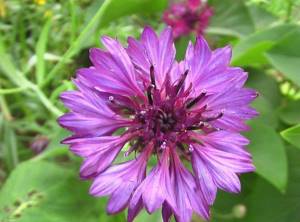
Purple cornflower grows up to 80 cm
Caring for garden cornflowers
Armeria flower - planting and care, varieties
Caring for cornflower is much easier than most garden plants. But still, there are certain features here. It is advisable to find out about them in advance, so as not to subsequently encounter unnecessary difficulties that could be easily avoided.
Watering mode
It is very important not to overdo it with watering. If it rains at least once a week, then you can completely refuse to additionally moisten the flowerbed. The fact is that cornflower is perfectly adapted to drought - the stems are dense, the leaves are few, narrow and hard. Therefore, it tolerates a lack of moisture much easier than its excess.
However, you should still monitor the health of the plant. Indeed, on hot and windy days, the evaporation of moisture from leaves and flowers increases, so if it begins to fade, you should still water it.

Bouquet of cornflowers
Top dressing
Annual plants are fed a couple of weeks before flowering - potassium fertilizers are used for this. Thanks to this, there are more buds, and the cornflower will be able to delight others with gorgeous flowers longer. Fertilizing should be repeated every two weeks until the end of the season or the end of flowering.
Perennial varieties are fed not only with potassium fertilizers, but also with phosphorus fertilizers. This should be done in early to mid-September. A single application of fertilizing is sufficient. Thanks to this, the cornflower will store enough nutrients in the roots to easily survive the cold season, and with the arrival of summer, again please the gardener with magnificent flowers.
So, although many people consider cornflower to be a simple weed, in the hands of an experienced gardener it can become a real decoration of any garden or flower bed. Moreover, the plant is very unpretentious and does not require constant care.
Centaur flower: planting and caring for perennial cornflower
Growing and caring for cornflower
An easy-to-care perennial that can fully grow and bloom in one area for 7 to 10 years. The main conditions for the successful development of plants are considered to be good air permeability and water permeability of the soil. During the growing season, it is necessary to loosen the soil several times in order to saturate it with oxygen and increase its water permeability when watering. While loosening the soil around the bushes, you need to weed out weeds at the same time.
Watering
The drought-resistant perennial will not tolerate frequent and abundant moisture. Even if we are talking about moisture-loving varieties or hybrids, it is necessary to focus on moderate soil moisture. In rainy summers, the crop is not watered at all.
Fertilizer
Fertilizing stimulates generous flowering of the crop, positively influencing its duration. The role of fertilizing especially increases in the case of growing perennials for cutting. Once or twice a month you need to feed the plants with complex mineral fertilizer at the rate of a tablespoon per square meter of planting. Excessive use of fertilizers threatens to result in yellowing of the foliage. Autumn fertilizing will help increase the winter hardiness of plants.
Trimming
Removing faded fragments not only solves aesthetic problems, but also prevents the ripening of seeds, the unauthorized spread of which can turn a well-groomed area into sloppy thickets. Experts offer two options for pruning plants that have finished flowering. In the first case, you can remove only the faded fragments themselves, leaving the stems and leaves. The second option involves almost completely removing the stem to a height of about 10 cm from ground level.
Diseases and pests
The perennial is famous for its excellent immunity and quite rarely becomes a target for disease attacks and pest attacks. Typically, problems can be caused by overwatering or excessive use of fertilizers. The appearance of dark spots on the stems and leaves of plants indicates infection with fusarium. Spraying with fungicidal preparations helps to overcome fungal disease. Sometimes it will be easier and more effective to remove the infected fragments and burn them.
In the absence of rain, the spider mite may become active; its presence can be detected by the appearance of spots on the foliage; later, the spotted leaves begin to turn yellow and fall off. After cutting off all infected fragments, you need to treat the bushes with an insecticide solution.
To prevent diseases and pests, you can sprinkle wood ash on your plants. Spraying with a soap solution helps repel pest attacks.
Cornflowers in winter
Frost-resistant perennials successfully tolerate even severe frosts without needing special winter shelter. The only activity that precedes the plant's entry into winter is cutting its stems to a height of 10 to 15 centimeters above ground level.


